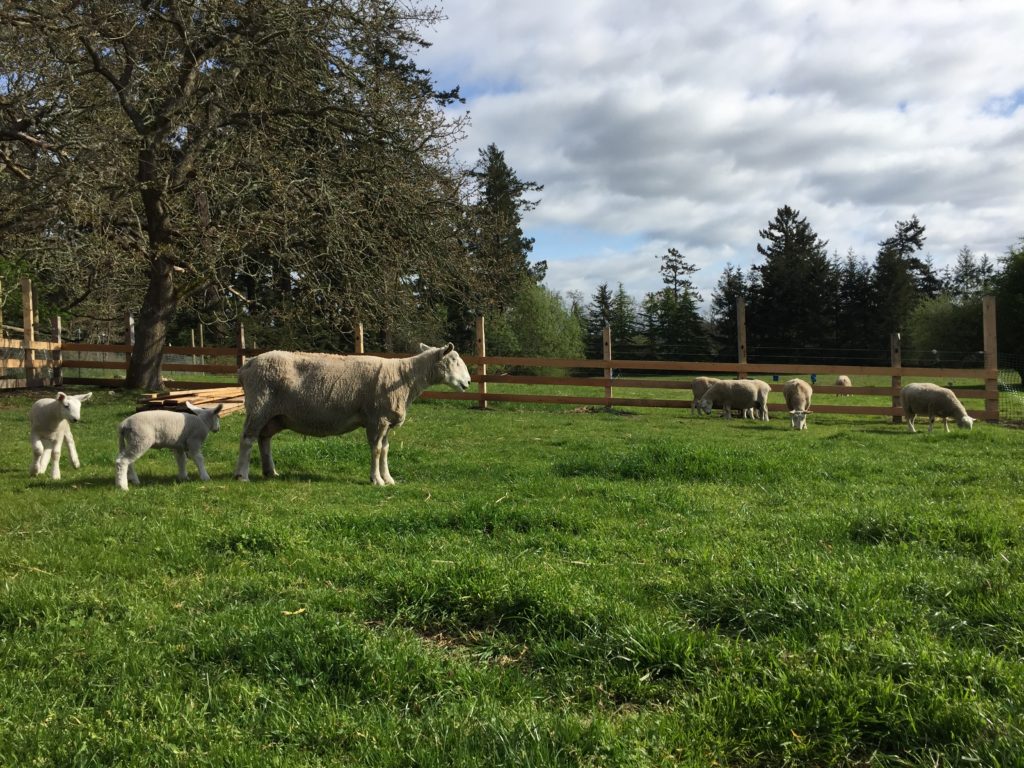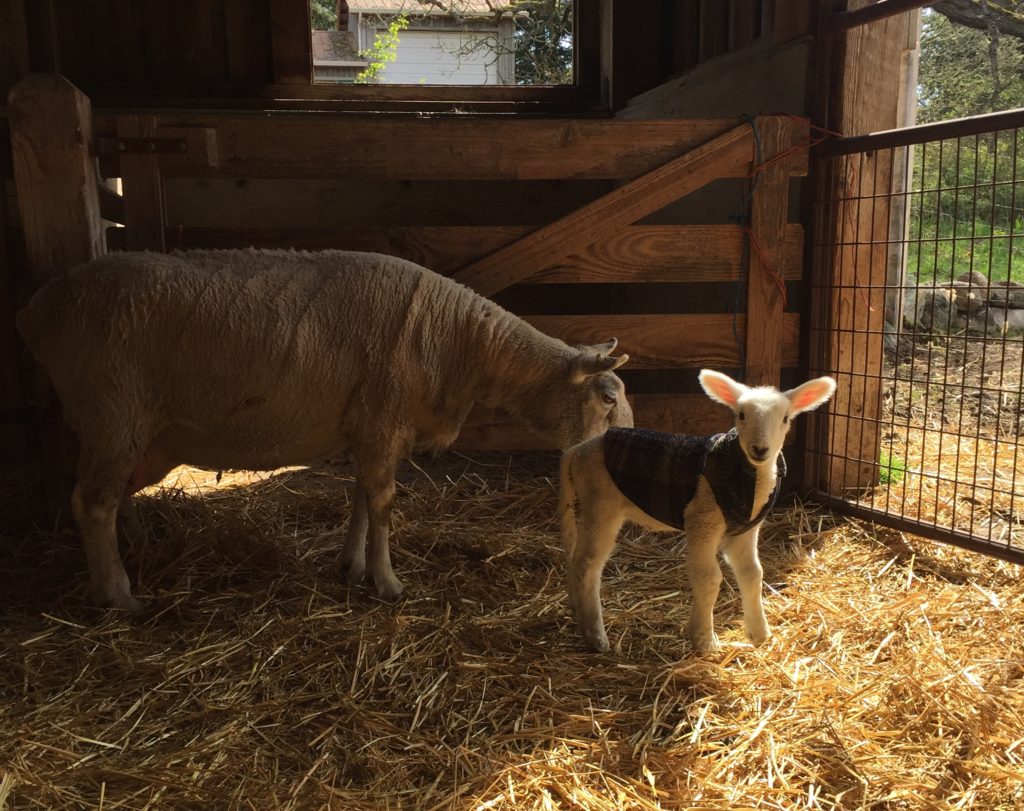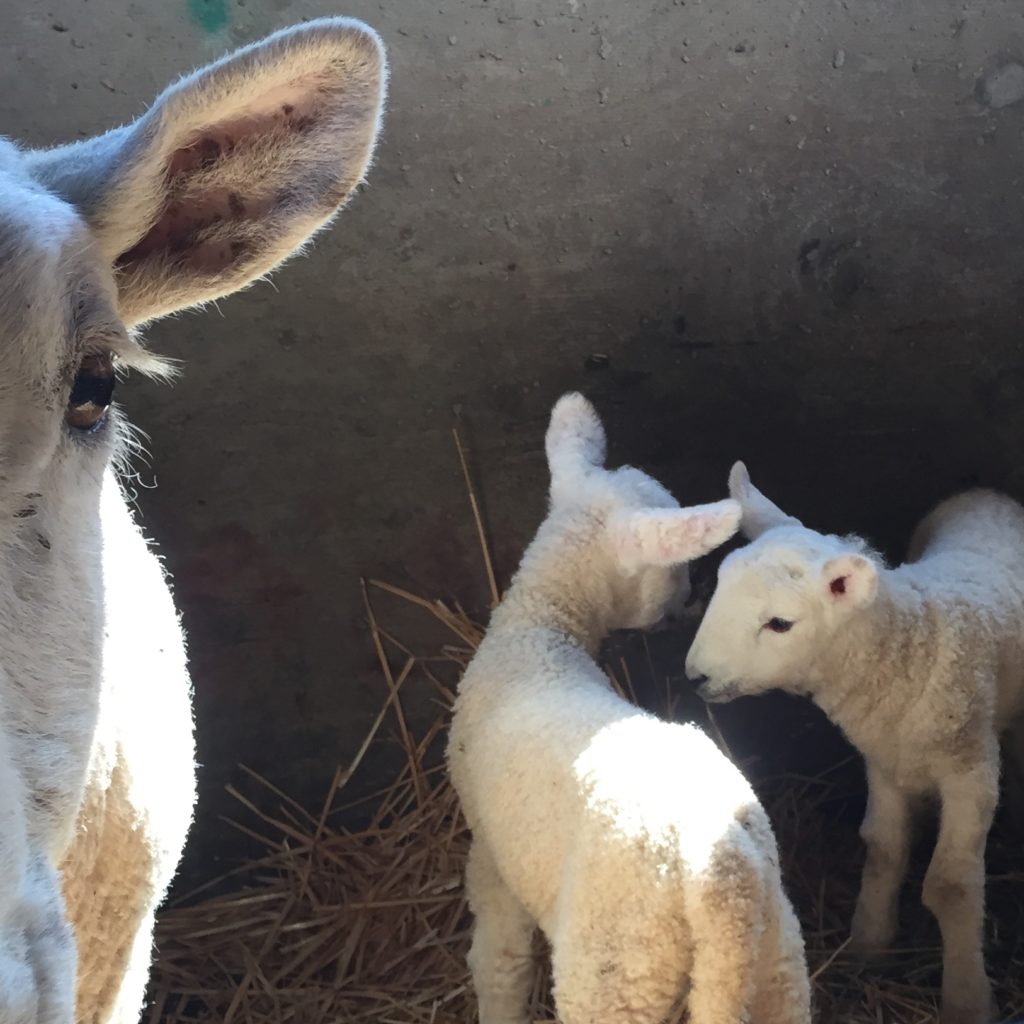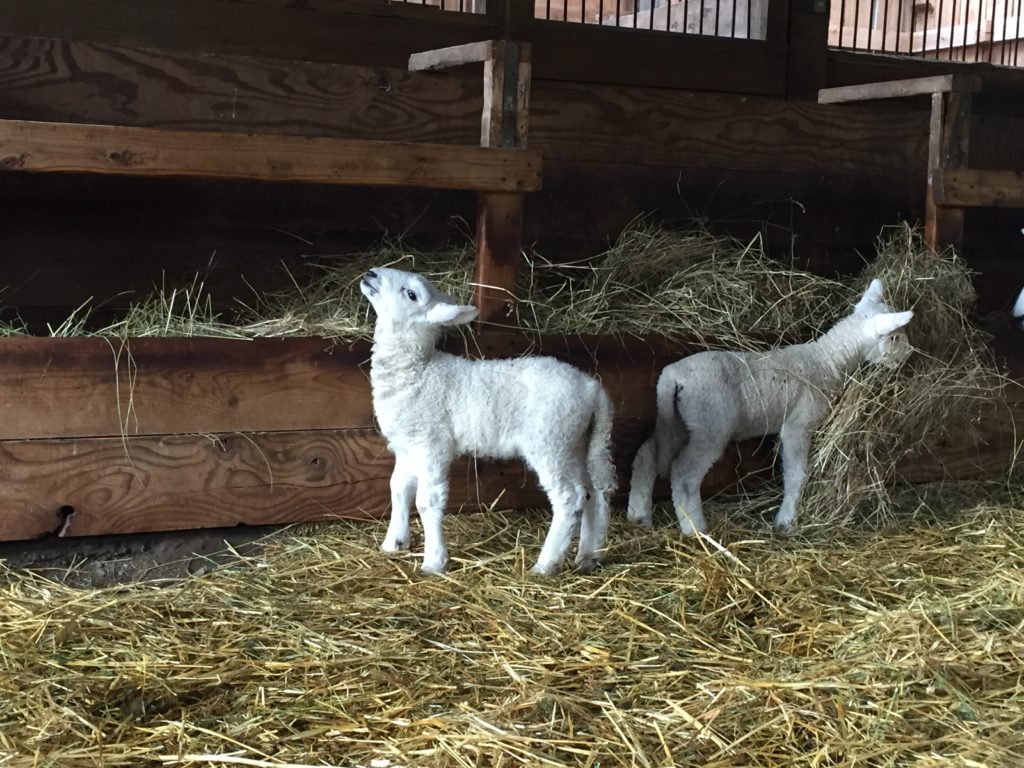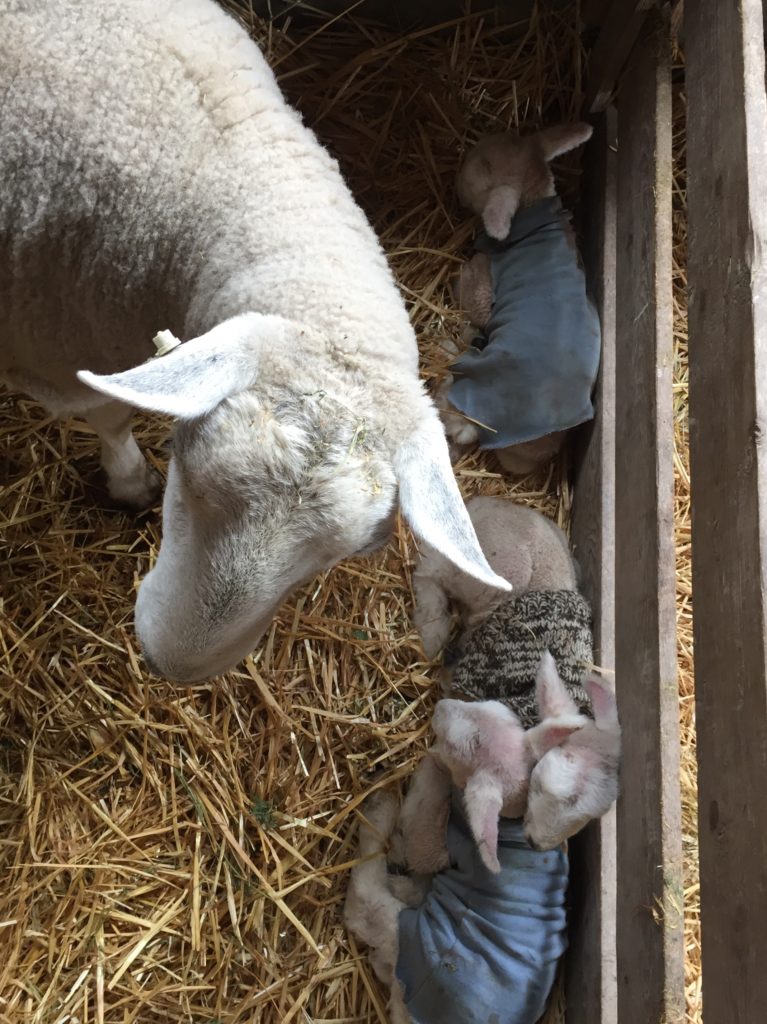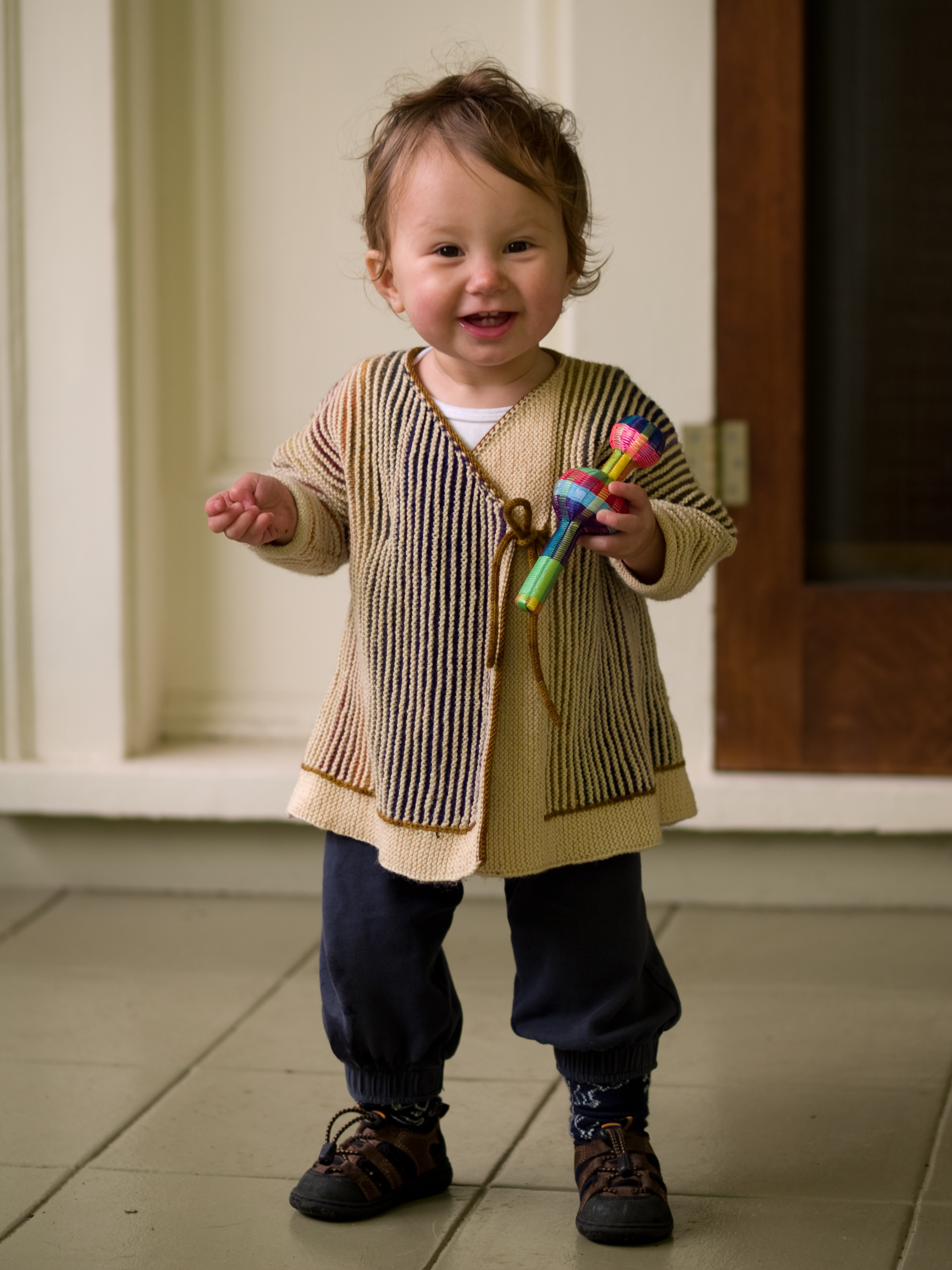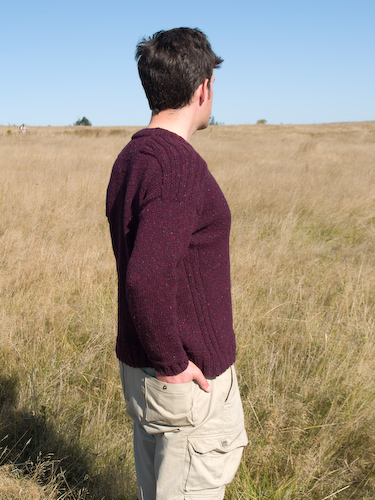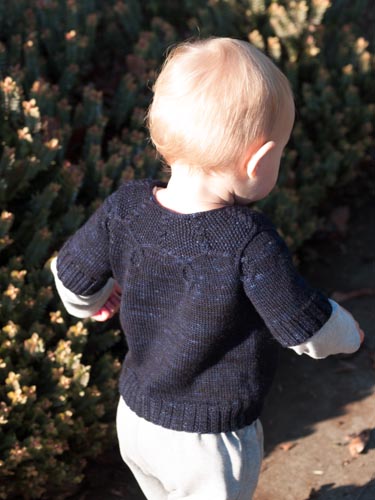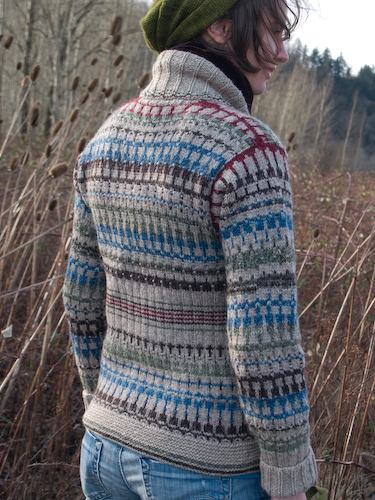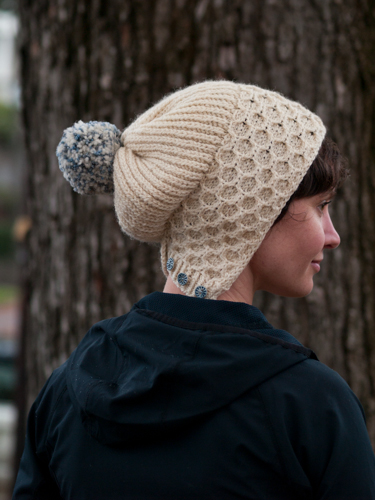Lambing season. April 9 was the date I circled on the calendar to begin night checks at the barn, 145 days after first possible conception for the seven ewes we put to Perseus and Hermes back in November. It feels like a season ago. The daffodils and plum blossoms are gone; now the dogwoods and apples are in full flower, as are the bluebells and the buttery scentless roses along the driveway. The fields are drunken vibrant green with new grass and spangled with dandelion seed puffs. Every evening is soft and luminous with sunset pastels and robin song.
This is the fourth week of trading shifts to tramp down to the barn in the dark, either near midnight or before dawn, to watch and wait for signs of lambs on the way. We both know what it looks like now. Sansa went first, a textbook labor and delivery despite her youth and inexperience. She pawed the straw, she circled the barn trying various spots, she whickered to her unborn lamb and licked the air. She lay down, she strained, she leapt up again and looked to see if anything had happened. She produced a bag of fluid and then, an hour and a half later, a neat pair of toes. We watched them emerge, retreat, emerge, retreat. It was my first chance to watch a birth. We were poised to spring in with the birthing tackle, to suction the new lamb’s mouth and nose and perform an increasingly acrobatic string of tricks if it should be slow to breathe. Like thoroughgoing beginners, we moved in too soon and Sansa took flight down the barn with the flock, her lamb still only halfway out. We scooped up her newborn and enticed her to follow him into the pen we’d prepared with fresh straw. He was a fine big fellow and didn’t need us, not really, but we fussed over him as Sansa licked him dry and we helped him to nurse and dipped his umbilical cord in iodine to prevent infection. The children named him Jupiter when they met him a few hours later. At three weeks of age he is a strapping, muscular fellow, long in the body like his father and with his mother’s stylish head carriage. He is a relentless imp, bounding atop the poor old grannies whenever they lie down to rest and dominating his week-old half-brother by chasing him in circles around the barn and paddock.
Athena with Pluto, her pretty ewe lamb
As so often happens at lambing time, there are sad notes, frustrations, regrets. Artemis delivered a stillborn, premature baby back in March. We count ourselves lucky that she showed no ill effects afterward. Athena gave birth to twins, and we were minutes too late arriving at the barn to revive her big ram lamb. Her daughter, Pluto, is beautiful and vigorous, but only nursed on the right side, and within a few days we were trying to fend off a case of mastitis on the side that should have fed the lost twin. We milked her out every four or five hours around the clock, discarding the infected milk and taking care not to spread the bacteria to other ewes.
There are moments of comedy, too. I left the island to pick up a thousand pounds of seed for the pastures, and meanwhile Adam caught Aphrodite in the act of delivering a very nice ewe lamb. When the twin (and I was sure there must be a twin in there; Aphrodite had been the size of an apartment complex for a month) hadn’t arrived an hour and a half later, I told Adam I thought he had better fetch it out. I’d read the lambing manual over and over during my night shifts and I’d been to a one-day lambing camp at a big sheep ranch in eastern Washington back in February, so I coached him through it on the phone while I sat in the truck in the ferry line. I sent him back to the house for chlorhexidine gluconate rinse to scrub his hands. It was a beautiful warm afternoon; all of us in the ferry line had our windows down or doors open to enjoy the sunshine. At some point I realized my husband, with his cell phone propped on the barn wall on speaker, might not be my only audience. I suspect a few fellow ferry riders learned a thing or two they weren’t expecting that afternoon. “If the cervix is too tight, run your fingers around in a circular motion and gently try to stretch it. Now open and close your fingers inside the vulva. That should stimulate a contraction.” The lamb had one leg back and an elbow locked on the pelvic bone; I talked Adam through walking his fingers up to pop the elbow loose and then pulling it by one leg, which I’d practiced at lambing camp on a dead lamb who sportingly donated his little body to science so a bunch of shepherds could work through the maneuvers that might help them save luckier babies. And it worked. Out she came, very weak, and Adam toiled over her to make her breathe and dangled her upside down and tickled her nose with straw and generally willed her into sticking around. We gave her a nutrient drench and a vitamin injection and she lasted through the night and was up and nursing on her own the next morning, a little stocky fluff ball of a lamb with a coat that waves rather than coils. Ada named her Venus.
Aphrodite’s girls, Venus and Starshine (you bet it’s after the Hair song)
We had another birth to remember when Persephone finally went into labor last weekend. I watched her Saturday night on our spanking new barn cam, rampaging around the barn harassing one of the oldest ewes the way a ram would. I perched myself on a hay bale and cast on a Littlewing vest for a human baby due to arrive soon and settled in to watch her labor. Three hours I watched her squat and lie down and strain, but to no effect. No fluid bag, nothing. I read the lambing manual again. (Laura Lawson’s Managing Your Ewe and Her Newborn Lambs. It’s been indispensible.) As I feared, the signs pointed to a breech baby plugging the dyke, in which case intervention was going to be absolutely necessary.
Persephone values her personal liberties and is one of the ewes Adam calls Tank 1 and Tank 2; she outweighs me by a clean hundred pounds even when she’s not pregnant and thinks nothing of plowing me into a wall. I didn’t fancy my chances of penning her for an exploratory feel on my own, so at 3am I woke Adam and mixed up the disinfectant wash. We corralled half the flock and, as predicted, Persephone barged around the pen like an angry rhinoceros and smashed my knee into the concrete while I tried to hang onto her so Adam could push the others back out again. We left her to cool down long enough to fetch the lambing kit, and then I scrubbed up for action. She struggled very briefly, but in my own experience a body doesn’t feel much like galumphing about during an internal exam, and the ewe seemed to agree with me and elected to cooperate.
It’s a curious experience, fishing for lambs. I found nothing at the cervix but bags of fluid and began to wonder exactly how far I’d have to reach in and whether I’d even recognize a lamb amongst all the hot slippery mysteries in there. Down, down below the pelvic bone my fingers touched something bony. A jawbone? Yes, there was an ear nearby. But no legs. Deeper in. Sorry, Persephone. There’s got to be a leg somewhere. Here! But is it a front leg, and does it belong to the same lamb? Back to the jawbone and down the shoulder to be sure. I worked the leg forward. It jerked away again. I can’t tell you how slippery a lamb leg in a birthing sac is. I gripped its tiny pastern between my thumb and forefinger with as much force as I could exert; my whole hand squeezing along the length of the leg wasn’t as strong a connection as I needed. I used the spare fingers to try to make sure the jawbone was coming along, too. Little by little I hauled my lamb foot and my jawbone up toward the birth canal, and I was spectacularly and repeatedly bathed in fluids as some of the sacs ruptured. (This post ought to have been sponsored by Grundens rain gear for fisherfolk; those pants really are waterproof!) I kept my grip on the single foot. Persephone pushed, I pulled. We rested a moment and tried again. Downward, downward. The book says to rotate the lamb a quarter as you’re pulling to bring the shoulders through more easily and to protect the lamb’s organs from bruising, but with only one leg out it didn’t seem possible. And then the head came free and the rest of her slipped out afterward. A strong little ewe, flapping her ears and struggling even before we had suctioned her mouth and nose.
The book also says to go right back in and get the second lamb immediately if you’ve had to pull the first one, so I did. Two feet to work with this time, and the nose nicely alongside. A smaller brother, not flapping any of his parts, rather weak. We worked over him as Persephone licked both her babies. The girl was suckling the air already, so I slid her aft under the teat, stripped out the wax plug for her, and on she went without even needing to stand up. The boy was still floppy. I held him to the nipple and milked it for him. Adam went to wake Ada, who’d wanted to witness a birth so badly. It was nearly 4am. I clipped and dipped umbilical cords and toweled sodden hides and tried to keep the lambs from floundering back into the puddles. Ada was beside me, helping the ewe lamb to find milk, passing me fresh towels. “Mom, what’s that sac hanging out?” she asked. “Oh, the afterbirth,” I answered without looking. There’s often a little red sac the size of an apricot along the cord to the placenta and I thought that’s what she’d noticed. Then I looked. It was not a little red sac the size of an apricot. It was a big white sac the size of a grapefruit, and that’s the sac that means a lamb is on the way. And sure enough, there he was, nose and toes coming right behind it. A tiny ram lamb, only half the size of some of the big singletons we’ve had, but full of vigor, up and sucking in no time. A proper little North Country, this one. We worried over the middle brother, still wobbling like a twig in a gale if he stood at all, and we gave him a vitamin drench and a shot of BoSe. I knew I’d gotten some colostrum into him, so I tucked him into the warmest of the knitted lamb sweaters, crossed my fingers for him, and wobbled off to bed myself as the neighbors’ rooster was doodling up the sun. And lo, we were both much stronger after a few hours’ rest.
Triplets! Comet, Saturn, and Ceres.
There’s one ewe left to lamb. I don’t think tonight is the night. Maybe Ruby will be kind and produce her babies at a nice civilized hour, say, between school drop-off and lunchtime. But it’s my turn on night drop patrol, so down I go to watch her behavior for a little while and to top up the triplets with a bottle before bed. (Persephone is mothering them all beautifully, but making food for three is a lot to ask and we are helping her out.) The stars are out, which means I’ll see Leo bowing to the western hills as I walk through the dark. My feet know the way to the barn. My hands know the way to a lamb. We’re still beginners, but we’re getting our seasoning.
